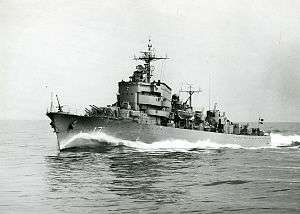Öland-class destroyer
 HSwMS Uppland | |
| Class overview | |
|---|---|
| Name: | Öland class |
| Operators: |
|
| Preceded by: | Visby class |
| Succeeded by: | Halland class |
| In commission: | 1947-1979 |
| Planned: | 4 |
| Completed: | 2 |
| Cancelled: | 2 |
| Retired: | 2 |
| General characteristics | |
| Type: | Destroyer/Frigate |
| Displacement: | 1,880-2,250 tons |
| Length: | 111 m (364 ft) |
| Beam: | 11.2 m (37 ft) |
| Draught: | 3.4 m (11 ft) |
| Speed: | 35 kn (65 km/h; 40 mph) |
| Complement: | 235 |
| Armament: |
|
The Öland class was a Swedish destroyer class. From 1943-1947 two destroyers were constructed, HSwMS Öland and HSwMS Uppland. Originally four ships were planned for the class but after the end of World War II two were canceled. When commissioned the ships were the largest destroyers that had ever served in the Swedish navy. The ships served in the navy until 1979 when the last ship was decommissioned.
Design
The Öland class was 111 metres (364 ft) long and had a displacement of 2,250 tons when fully loaded making it, when commissioned, the largest destroyer class in the navy. Because of their weight the destroyers were constructed with a double hull to withstand damages better. Some parts of the inner hull were made of armor to protect important parts like the engine room ecs.[1]
References
Sources
- Borgenstam, Curt; Insulander, Per; Kaudern, Gösta (1989), Jagare : med svenska flottans jagare under 80 år (2:a ed.), Karlskrona: Västra Frölunda CB Marinlitteratur, ISBN 91-970700-4-1
- von Hofsten, Gustav; Waernberg, Jan (2003), Örlogsfartyg: Svenska maskindrivna fartyg under tretungad flagg (1:a ed.), Karlskrona: Svenskt Militärhistoriskt Bibliotek, ISBN 91-974015-4-4